 Expert's opinion
Expert's opinion
Expert's opinion
The article is a subjective view on this topic written by writers specializing in medical writing.
It may reflect on a personal journey surrounding struggles with an illness or medical condition, involve product comparisons, diet considerations, or other health-related opinions.
Although the view is entirely that of the writer, it is based on academic experiences and scientific research they have conducted; it is fact-checked by a team of degreed medical experts, and validated by sources attached to the article.
The numbers in parenthesis (1,2,3) will take you to clickable links to related scientific papers.
7 Superfoods For Menopause 2024: Diet & Foods Recommendation

Menopause is a phase in women’s life. Symptoms that come before, during, and after menopause can be challenging for some women. Thus they seek home remedies for minimizing menopausal symptoms.
Foods are fuel for our bodies; healthy and balanced nutrition providing nutrients can make a menopause transition a bit easier. In this article, you’ll find healthy foods, so-called superfoods for menopause.
7 Best Superfoods For Menopause
Here you will find healthy and nutrient-dense superfoods for menopause that promote your recommended diet’s nutrient content:
- Green leafy vegetables
- Cruciferous vegetables
- Soy
- Beans
- Berries
- Citrus
- Milk and yogurt
Menopause Diet: 7 Superfoods To Eat
Some nutrient-rich foods are marketed as superfoods[1] to increase sales. However, there is no acknowledged definition of superfood by the Food and Drug Administration (FDA) or other health authorities.
Superfood is often used to describe foods rich in certain nutrients or bioactive compounds. Yes, some foods are more nutrient-rich than others, according to the Centers for Disease Control and Prevention (CDC).[2]
Some foods are examined for their nutrient density, and foods containing 10% and more daily value of 17 specific nutrients per 100kcal are called powerhouse fruits and vegetables.
These fruits and vegetables are rich in potassium, fiber, protein, calcium, iron, zinc, B-complex vitamins, and vitamins A, C, D, E, and K.
However, remember that eating just one or a few specific foods cannot make you healthier. Healthy and balanced nutrition with moderate physical activity is the way to be healthy.
Here you will find healthy and nutrient-dense superfoods for menopause that promote your recommended diet’s nutrient content:
Green Leafy Vegetables
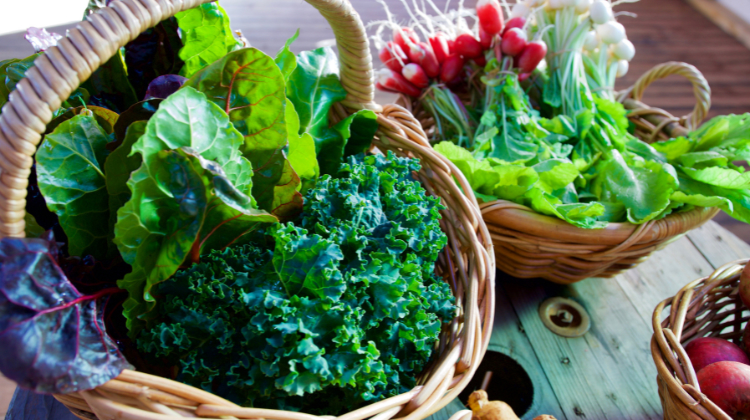
Spinach, beet green, chard, chicory, and leaf lettuce are nutrient-dense green leafy vegetables that are rich[3] in vitamin A, vitamin C, vitamin E, vitamin K, calcium, potassium, and iron. They contain low calories while providing high fiber. You can add these vegetables to salads, soups, and side dishes.
Cruciferous Vegetables
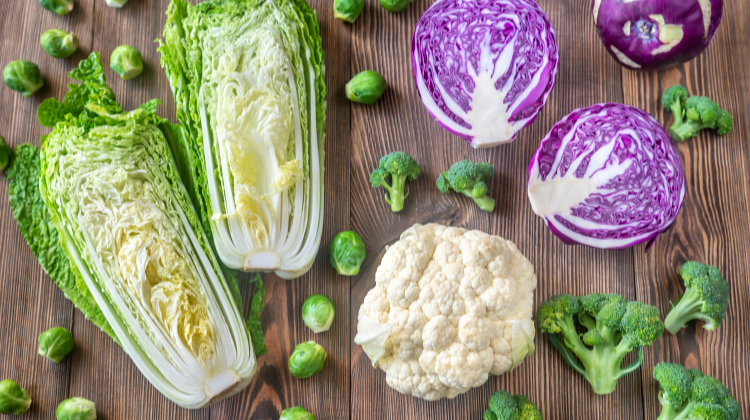
The top 2[2] nutrient-rich vegetables on the list of powerhouse fruits and vegetables are watercress and Chinese cabbage. Other nutrient-rich cruciferous vegetables are collard greens, kale, and arugula. They make a great salad or a base for your oatmeal or smoothie.
Soy
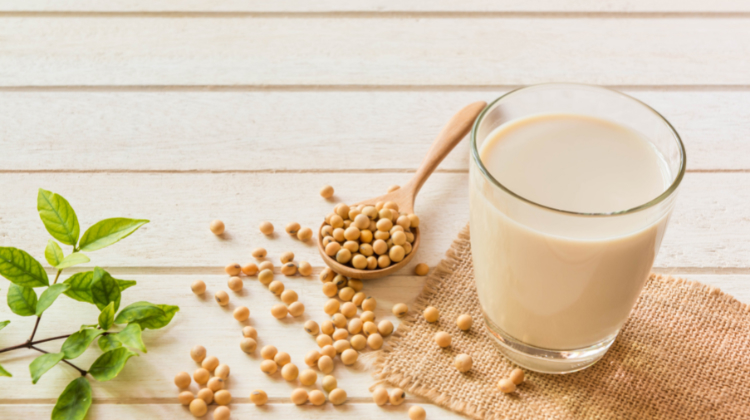
Soy contains isoflavones which are compounds that have a similar structure to the estrogen hormone. Soy products are used for menopausal symptoms, bone health, and improving blood pressure, cholesterol, and memory.
Soy isoflavone supplements may slightly help[4] with menopausal symptoms. Some people may experience digestive issues such as constipation or diarrhea when consuming soy.
Beans

Beans are a great source of plant-based protein. ½ cup of cooked kidney beans[5] provides protein equal to an ounce of cooked beef.[6] They are not high in saturated fats as meat is. Using of canned beans is convenient. Put in your salad as a protein source or cook them with whole grains.
Berries
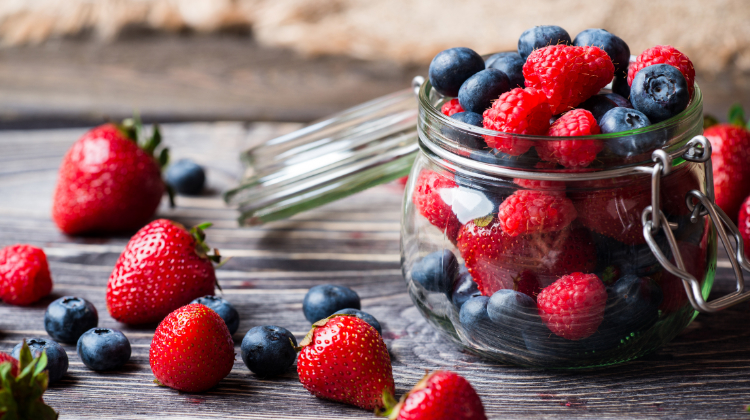
Berries[7] are rich in vitamin C, K, potassium, folate, manganese, and copper. 2 of the nutrient-dense berries are strawberry and blackberry. One cup of strawberries[8] provides 99% of your daily vitamin C needs. You can add berries to your oatmeal or fruit salads.
Citrus
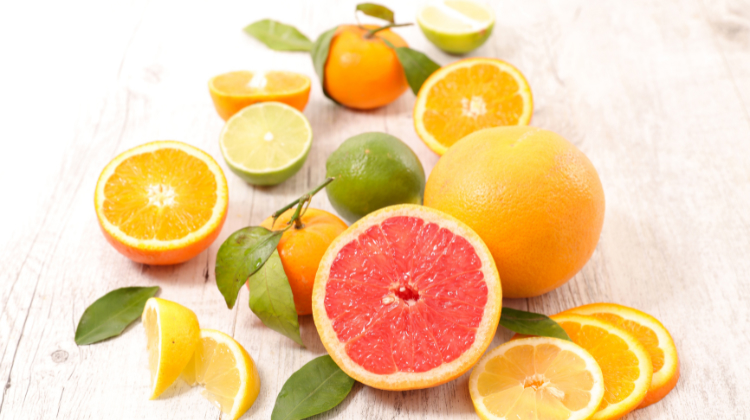
Citrus such as lemon, orange, lime, and grapefruit are rich in antioxidants and vitamins. Antioxidants capture harmful molecules (free radicals) within your body and reduce inflammation caused by these harmful substances.
Inflammation causes inflammatory states and chronic diseases, such as diabetes and heart diseases; thus, consuming enough antioxidants is recommended for health.
Milk and yogurt
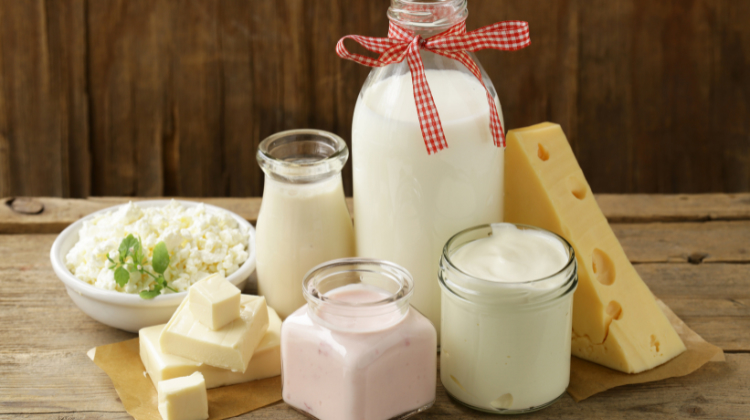
Menopausal women are at high risk of osteoporosis. Nutrition before and after menopause is critical for bone health. Calcium-rich foods would give nutritional support for bone health.
Dairy products are high in calcium and phosphorus and contain some vitamin D, nutrients essential for healthy bones. 1 cup of whole milk yogurt[9] provides you with 16% of your daily calcium needs.
There are a lot of products[10] on the market that falsely claim that they reduce menopause symptoms. Although some vegetables, legumes, and herbs contain phytoestrogens, their effects on health are not well studied, so long-term effects are unknown. That’s why you should always consult your doctor before taking any products.
Symptoms of Menopause
Menopause[11] naturally happens when hormones estrogen and progesterone production stop in the ovaries. On average, women experience menopause between 44-55 years of age. Symptoms of menopause can be
- Hot flashes
- Night sweats
- Mood swings
- Vaginal dryness
- Urinary incontinence
- Decreased sleep quality
- Changes in the menstrual period – changes in duration, intensity, and the time interval between periods
Management of symptoms
Menopause symptoms may significantly impact women’s life. It is best to get help from healthcare professionals to manage your symptoms.
Menopause
“Official menopause” is defined as going a whole year without any periods. Although the average age for this is 52, everyone is different. You don’t have to be in “official” menopause to have symptoms, because the approach to menopause can take 10-15 years. Thus, you can begin to have symptoms well before the average age of menopause.
Before menopause
Changes[12] may start long before menopause. Your period may begin to become irregular and/or heavier. You may begin to have mood swings and hot flashes (occasionally at first, but more frequent as you approach menopause age.) You should talk with a healthcare provider if you experience changes in your periods or bleeding. You can ask for a safe time to quit birth control.
During menopause
You may experience hot flashes, mood changes, vaginal dryness, and bone health problems. Sometimes menopause symptoms don’t go away or the intensity of symptoms may increase. In that case, talk to the doctor about the appropriate treatments. Some women are given hormone treatments and non-hormone treatments.
After menopause
Heart and bone health become crucial with menopause. Hormonal changes may lead to thinned bones and osteoporosis. This raises the risk of hip and other fractures.
What Changes Happen During Menopause?
Weight gain
The average weight gain after menopause is around 5 pounds[13]. Your metabolism slows down because of aging, lower physical activity levels, loss of muscle mass, and estrogen levels.
Although it is normal to experience changes in your body, weight gain may increase blood sugar, cholesterol and pressure, thus increasing the risk of diabetes, heart attack, and stroke.
Bone changes
After age 35, some degree of bone loss[14] is normal as you age. However, bone loss may accelerate during 4-8 years after menopause due to the effects on the bone from insufficient estrogen.
Women at menopausal transformation or menopause have an increased risk for osteoporosis if too much bone is lost. Bone fractures on the hip, wrist, and spines may be seen due to osteoporosis.
Changes in Heart Health
Estrogen protects women from heart disease, including heart attacks and stroke. Estrogen is still produced after menopause, but a small amount of estrogen is not as protective.
Other risk factors for heart disease, such as high blood pressure and high cholesterol, become common after midlife. Thus healthy nutrition and physical activity get more critical.
Foods & Drinks To Avoid During Menopause
A healthy diet is one of the keys to managing health during and after menopause. Here are some foods to avoid to stay healthy:
High-calorie but poor-nutrient foods
Staying at a healthy weight is more challenging for menopausal women. Try to avoid sugary, junk, and high-fat foods, or consume them in moderation because they contain high calories but are low in nutrients.
Unhealthy Fats
Your body needs fats to function properly. However, you should choose healthy fats (unsaturated fats) over saturated fats.
Salty & Spicy Foods
Spicy foods may trigger symptoms like hot flashes. Salt contains sodium, which can cause fluid retention. If you consume excessive amounts of salty meals or high sodium packaged foods, you may exceed the daily sodium limit of 2300 mg[15], which equals 6 g of salt.
You should watch your sodium intake as women become more prone to increased blood pressure, heart disease, and stroke after menopause.
Caffeine & Alcohol
Try to avoid alcohol[16]. If you drink alcohol, limit it to one drink on the days you consume alcohol.
The Takeaway
Although mentioned superfoods are natural and healthy, promoting certain foods as magical foods is not the right approach to healthy and balanced nutrition. There are a lot of superfoods that help with menopause, naturally, within a healthy and balanced nutrition plan.
It is best[17] to not focus on a few specific foods; instead, have a balanced menopause diet containing various healthy foods.
+ 17 sources
Health Canal avoids using tertiary references. We have strict sourcing guidelines and rely on peer-reviewed studies, academic researches from medical associations and institutions. To ensure the accuracy of articles in Health Canal, you can read more about the editorial process here
- Nutrition.org.uk. (2018). Functional foods – British Nutrition Foundation – Page #1. [online] Available at: https://archive.nutrition.org.uk/nutritionscience/foodfacts/functional-foods.html?start=3
- Di Noia, J. (2014). Defining Powerhouse Fruits and Vegetables: A Nutrient Density Approach. Preventing Chronic Disease, [online] 11. doi:10.5888/pcd11.130390.
- Diabetes.org. (2022). Diabetes Superstar Foods | ADA. [online] Available at: https://www.diabetes.org/healthy-living/recipes-nutrition/eating-well/diabetes-superstar-foods
- NCCIH. (2016). Soy. [online] Available at: https://www.nccih.nih.gov/health/soy
- Nutritionvalue.org. (2022). Beans, with salt, boiled, cooked, mature seeds, red, kidney nutrition facts and analysis. [online] Available at: https://www.nutritionvalue.org/Beans%2C_with_salt%2C_boiled%2C_cooked%2C_mature_seeds%2C_red%2C_kidney_nutritional_value.html
- Nutritionvalue.org. (2022). Beef, lean only eaten, cooked, stew meat nutrition facts and analysis. [online] Available at: https://www.nutritionvalue.org/Beef%2C_lean_only_eaten%2C_cooked%2C_stew_meat_21410120_nutritional_value.html?size=1+ounce+%3D+28.3495+g
- Usda.gov. (2022). FoodData Central. [online] Available at: https://fdc.nal.usda.gov/fdc-app.html#/food-details/1102699/nutrients
- Nutritionvalue.org. (2022). Strawberries, raw nutrition facts and analysis. [online] Available at: https://www.nutritionvalue.org/Strawberries%2C_raw_nutritional_value.html
- Nutritionvalue.org. (2022). Yogurt, whole milk, plain nutrition facts and analysis. [online] Available at: https://www.nutritionvalue.org/Yogurt%2C_whole_milk%2C_plain_nutritional_value.html
- https://www.facebook.com/NIHAging (2021). Hot Flashes: What Can I Do? [online] National Institute on Aging. Available at: https://www.nia.nih.gov/health/hot-flashes-what-can-i-do
- Medlineplus.gov. (2016). Menopause. [online] Available at: https://medlineplus.gov/menopause.html
- Office (2019). Menopause. [online] U.S. Food and Drug Administration. Available at: https://www.fda.gov/consumers/womens-health-topics/menopause#BeforeMenopause
- Womenshealth.gov. (2015). Menopause and your health | Office on Women’s Health. [online] Available at: https://www.womenshealth.gov/menopause/menopause-and-your-health
- Acog.org. (2018). The Menopause Years. [online] Available at: https://www.acog.org/womens-health/faqs/the-menopause-years.
- CDC (2022). Salt. [online] Centers for Disease Control and Prevention. Available at: https://www.cdc.gov/salt/index.htm
- Eatright.org. (2022). Healthy Eating During Menopause. [online] Available at: https://www.eatright.org/health/wellness/healthy-aging/healthy-eating-during-menopause
- The Nutrition Source. (2018). Superfoods or Superhype? [online] Available at: https://www.hsph.harvard.edu/nutritionsource/superfoods/.



